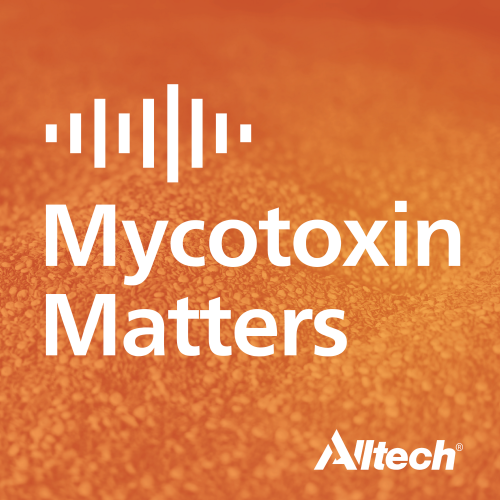Keep ahead of the threat
Stay up to date with the latest mycotoxin information by signing up to our newsletter

Gut health and mycotoxins: What do we know so far?
Click below to listen to the Mycotoxin Matters podcast episode with Dr. Alexandra Weaver hosted by Nick Adams. You can also hear the full audio or listen to the episode on Apple Podcasts or Spotify. You can find an edited transcript at the bottom of the page.
Author: Dr. Radka Borutova, DVM, PhD: European Technical Support Manager, Alltech Mycotoxin Management
Introduction
The gastrointestinal tract represents the first barrier against ingested chemicals, feed contaminants and natural toxins. Following ingestion of mycotoxin-contaminated feed, intestinal epithelial cells can be exposed to high concentrations of toxins. This is especially important when considering toxins with poor intestinal absorption, such as fumonisin B1 (FB1). The biological actions of mycotoxins can cause direct intestinal damage. Trichothecenes affect actively dividing cells, such as those lining the gastrointestinal tract. They directly affect protein synthesis in eukaryotic cells due to the interaction with the ribosomal units, preventing either initiation of protein synthesis or elongation of the polypeptidic chains. It should be noted that the gastrointestinal tract (GIT) is also sensitive to trichothecene-induced apoptosis, affecting mainly the gastric mucosa, gastric granular epithelium and intestinal crypt cell epithelium. The toxic action of trichothecenes results in extensive necrosis of oral mucosa and gizzard lesions. The T-2 toxin inhibits DNA, RNA and protein synthesis in eukaryotic cells, affecting the cell cycle and inducing apoptosis both in vivo and in vitro. It should also be mentioned that the primary effect of T-2 toxin is executed through its contact with the mouth epithelium (beak cavity and tongue).
Direct impact of mycotoxins on the gastrointestinal barrier
Another important effect of some mycotoxins is that they alter the barrier function of the intestinal epithelium, which is measured as a decrease in the transepithelial electrical resistance (TEER). It is likely that the environment surrounding the tight junctions is somehow altered by continuous exposure to mycotoxins. For example, poults fed grains naturally contaminated with Fusarium mycotoxins had decreased villus height in the duodenum and decreased villus height and villus surface in the jejunum during the starter period. Another example could be turkeys which were fed the same diet contaminated with Fusarium mycotoxins, the width and villus surface of the duodenum, villus height and surface of the jejunum and submucosal thickness of ileum decreased during the grower phase.
Mycotoxin impact on gut biochemistry
Mycotoxin can also impact on gut biochemistry. Aflatoxins fed to broiler chickens decreased pancreatic secretions, whereas aflatoxins fed to layers increased the production of pancreatic enzymes. Intestinal morphology (intestinal crypt depth) and the specific activity of intestinal disaccharidase and maltase were also altered by feeding AFB1. This generates a change in the chemistry of the luminal environment. The bacteria that are most suitable to the new luminal environment will have more chances of successfully multiplying.
In addition to the morphological changes induced to the intestinal villi by DON, it is suggested that this mycotoxin inhibits Na+ transport and Na+-D-glucose co-transport in the jejunum of layers.
So, the quality and quantity of nutrients available in the intestinal lumen changes since absorption capacity is altered. It is likely that species of bacteria that can successfully ferment the new “luminal diet” will predominate in the lumen.
Mycotoxins and infectious agents
Finally, mycotoxins open the gate for infectious agents. In an experimental necrotic enteritis (caused by Clostridium perfringens) infection model, broiler chickens fed a diet contaminated with 5 mg DON/kg of feed were more prone to developing necrotic enteritis lesions compared to chickens on a control diet. In that case, DON acted as a predisposing factor by damaging the intestinal mucosa, leading to leakage of nutrients into the intestinal lumen, therefore providing the necessary growth substrate for extensive proliferation of C. perfringens.
Mitigating the mycotoxin threat
To effectively manage the inevitability of feed mycotoxin contamination, it is crucial to understand the level of mycotoxin challenges so that the right steps can be taken to mitigate any adverse effects on animal performance, production efficiency and food safety. Using a combination of powerful management tools, the Alltech® Mycotoxin Management Program provides a complete holistic solution to help producers take control of mycotoxin contamination and protect their businesses. The program is built around next-generation risk identification technology, data analysis and insights and mycotoxin binder solutions designed to reduce the damaging effects of mycotoxins on animal health and production potential.
References available on request








